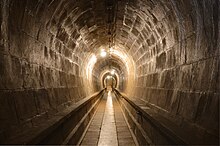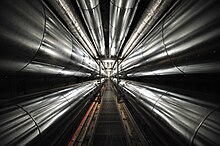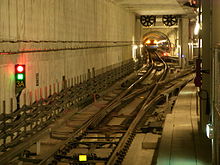A communication channel created in a computer network by encapsulating a communication protocol’s data packets in (on top of) a second protocol that normally would be carried above, or at the same layer as, the first one. Most often, a tunnel is a logical point-to-point link – i.e., an OSI layer 2 connection – created by encapsulating the layer 2 protocol in a transport protocol (such as TCP), in a network or inter-network layer protocol (such as IP), or in another link layer protocol. Tunneling can move data between computers that use a protocol not supported by the network connecting them.


A tunnel is an underground passageway, dug through the surrounding soil/earth/rock and enclosed except for entrance and exit, commonly at each end. A pipeline is not a tunnel, though some recent tunnels have used immersed tube construction techniques rather than traditional tunnel boring methods.
A tunnel may be for foot or vehicular road traffic, for rail traffic, or for a canal. The central portions of a rapid transit network are usually in the tunnel. Some tunnels are aqueducts to supply water for consumption or for hydroelectric stations or are sewers. Utility tunnels are used for routing steam, chilled water, electrical power or telecommunication cables, as well as connecting buildings for convenient passage of people and equipment.
Secret tunnels are built for military purposes, or by civilians for smuggling of weapons, contraband, or people. Special tunnels, such as wildlife crossings, are built to allow wildlife to cross human-made barriers safely. Tunnels can be connected together in tunnel networks.





